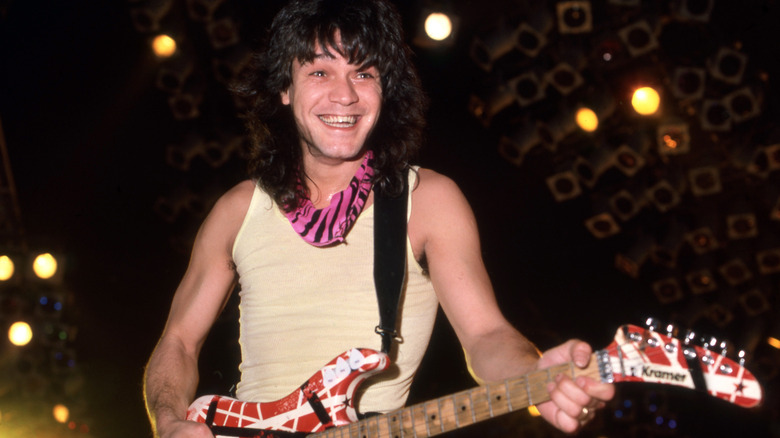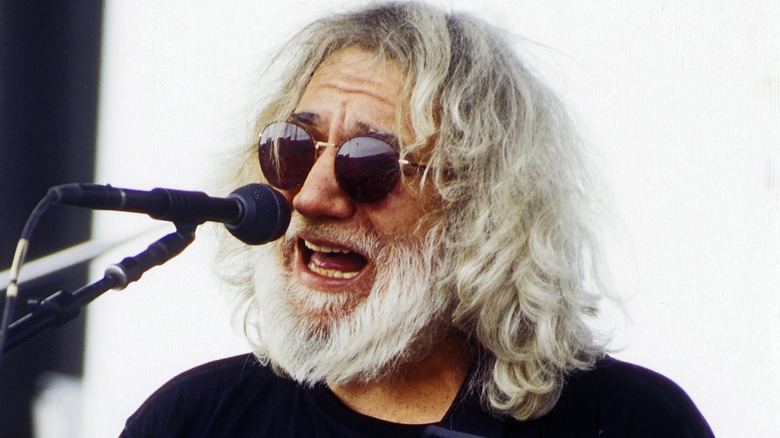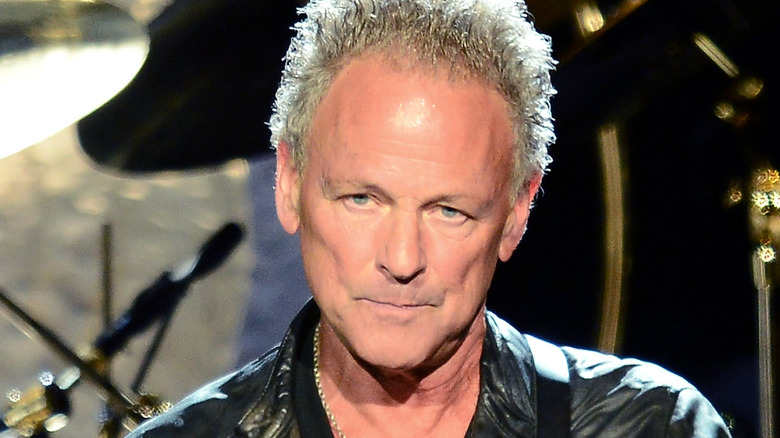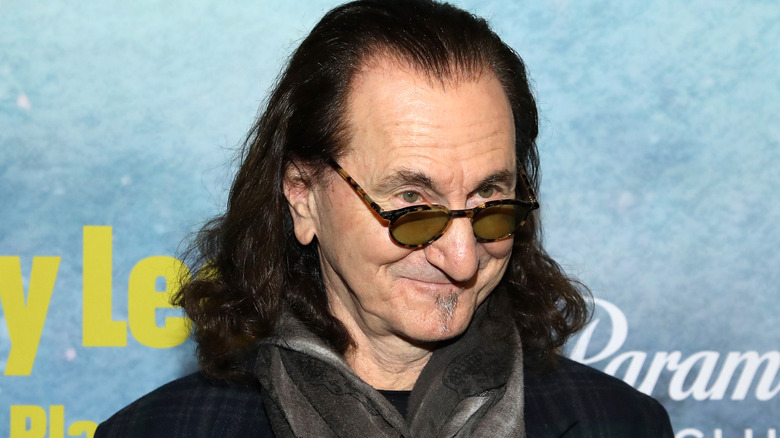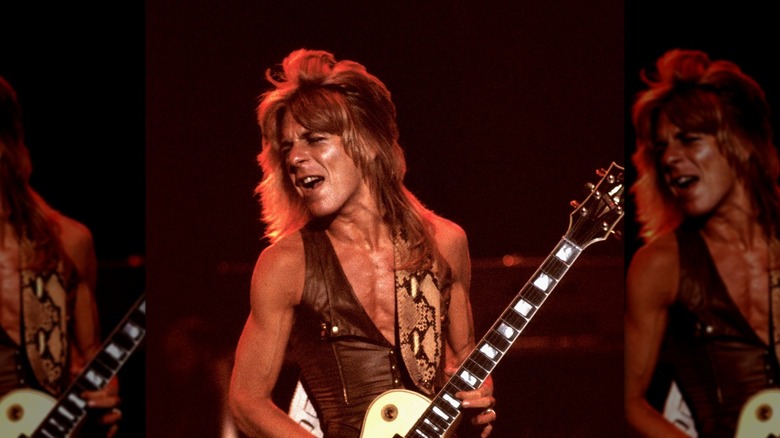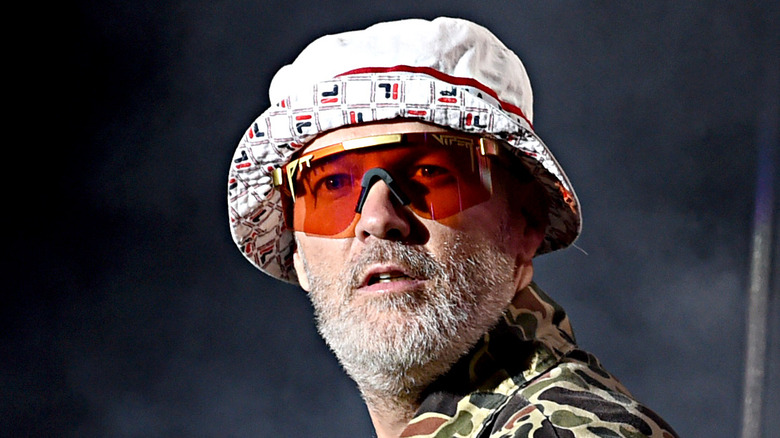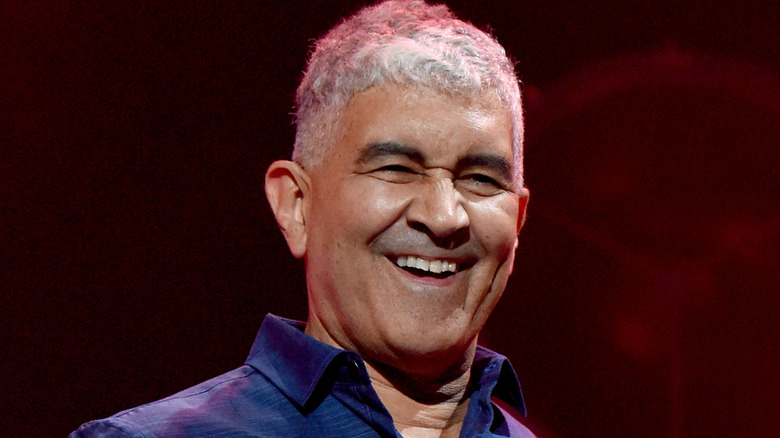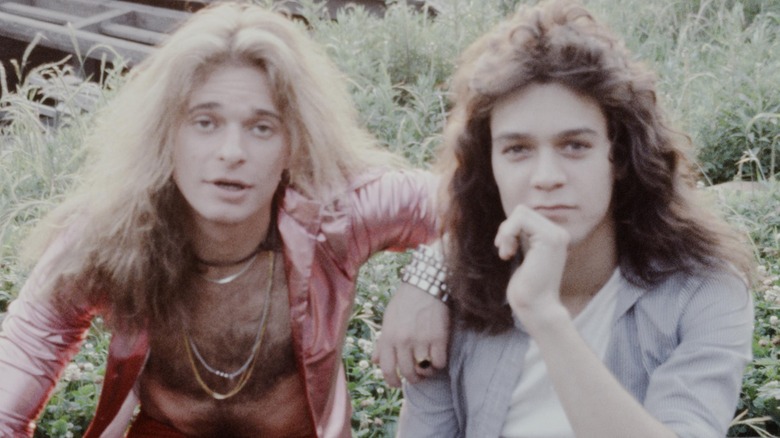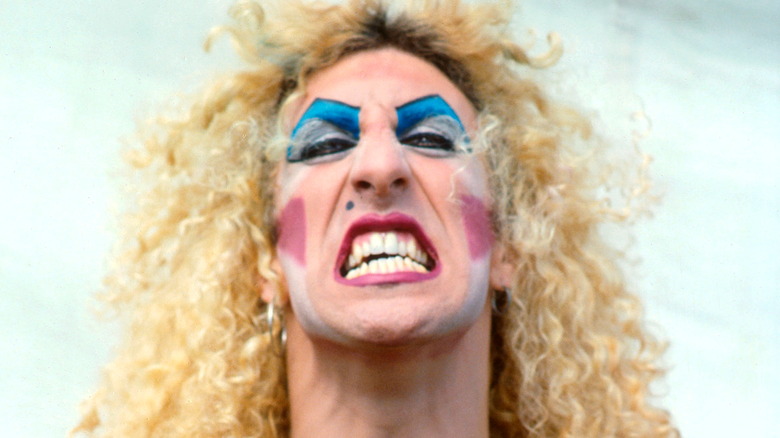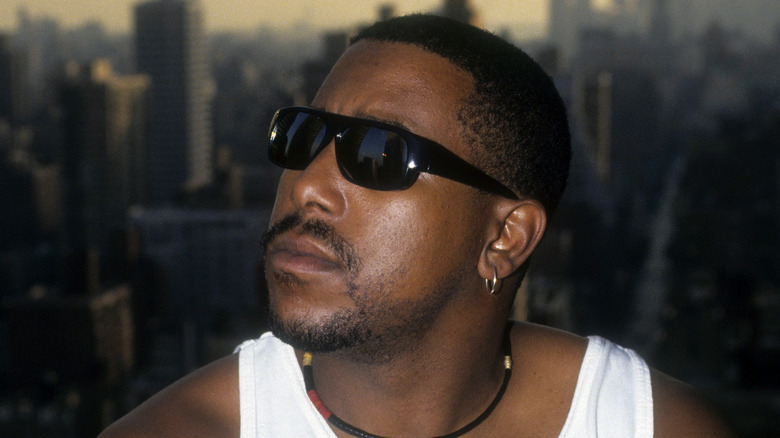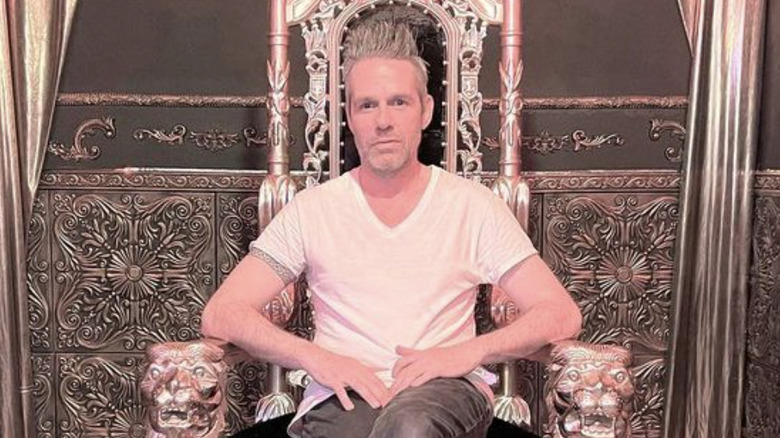Stars Who Couldn't Stand Eddie Van Halen
With sales of about 80 million records via the band named after himself and his brother, along with critical acclaim, and hailed by his peers as an influence, genius, and pioneer, Eddie Van Halen is easily one of the most beloved characters in the history of popular music. Exhibiting superhuman-level powers of guitar technique, keyboard playing, and songwriting, it's hard to believe that Eddie Van Halen was a human being, and a flawed one at that.
Just like the rest of us mortals, he wasn't 100% likable or always nice or fair with everyone all the time, certainly not across the 60-plus years of his lifetime. And for those reasons and more, Van Halen made a handful of enemies. Even more shocking: Those foes were celebrities, almost as famous as Van Halen himself, and they were willing to talk about how the guitarist did them wrong and why, exactly, they didn't much care for the legendary shredder. Here are some of the enemies and adversaries of Eddie Van Halen, the seemingly rare individuals who just really didn't like the guy.
Jerry Garcia
One of the most influential and skilled guitarists to come out of the 1960s and early 1970s: Jerry Garcia, the chief musical architect of cult superstars the Grateful Dead. One of the most impressive electric guitarists of the 1970s and 1980s: Eddie Van Halen, the gifted and exceptionally proficient centerpiece of hard rock foursome Van Halen. While both are among the most famous and acclaimed guitarists of all time, their musical approaches and techniques varied greatly, to the point where Garcia wasn't much impressed by Van Halen's ultra-fast playing style.
In a 1985 interview with "Frets Magazine," Garcia declared that he didn't listen to Van Halen's records because they didn't wow him. "Because I can hear what's happening in there. There isn't much there that interests me. It isn't played with enough deliberateness, and it lacks a certain kind of rhythmic elegance that I like music to have, that I like notes to have," he said. "There's a lot of notes and stuff, but the notes aren't saying much, you know."
Lindsey Buckingham
In 1977, Fleetwood Mac released "Rumours," a soft rock opus about the band members' romantic squabbles that went on to become one of the biggest-selling albums of all time. The year after, Van Halen released its self-titled debut, a loud and heavy collection that would rocket the band to the top of the rock world. Fleetwood Mac's lead guitarist, Lindsey Buckingham, declared his style of play — which pulled heavily from folk music and banjo-picking methods — to be antithetical and superior to that of the other band's chief axeman, Eddie Van Halen, who used both his hands to speedily soar up and down his instrument's fretboard, to the delight of his fans.
"I've always believed that you play to highlight the song, not to highlight the player. The song is all that matters," Buckingham told Guitar World Acoustic (via Far Out) in 2012, meaning that his work serves his bandmates' compositions, while Van Halen is little more than a showoff. "There are two ways you can choose to go. You can try to be someone like Eddie Van Halen, who is a great guitarist, a virtuoso. Yet he doesn't make good records because what he plays is totally lost in the context of this band's music."
Geddy Lee
In June 1980, Van Halen played a show in Leicester, England, the same night that progressive rock band Rush was in town. Rush rented out a bar to celebrate, and Van Halen's road crew crashed the party. "And they cleaned the place out, which put their guys on edge a little bit," Van Halen singer David Lee Roth told Creem in 1981 (via 2112.net). Nevertheless, Rush bassist Geddy Lee let the members of Van Halen into the bar and hung out with Eddie Van Halen. "They'd both been drinking a little bit, and Geddy was playing some Rush tapes on a tape recorder. He said something to Ed and Ed's beer got into the tape recorder," Roth explained. "Well that caused a little friction."
A year later, Lee and Rush had their revenge. Rush opened for Van Halen in Las Vegas in 1981 and told the venue to not let anyone associated with the headliner in to see Rush play. The bands' crews talked it out, and Rush relented, allowing a few guys to see its concert. Late that night, after both bands played their sets, Lee approached Eddie Van Halen in a casino with his hand out, seeking to make amends. Instead, he got slammed to the ground. "One of our security guards didn't have the vaguest idea in hell who he was and he came up and bodytackled him," Roth said.
Randy Rhoads
Two fast-fingered electric guitar kings reigned over early '80s hard rock: Eddie Van Halen and Randy Rhoads, lead guitarist in Quiet Riot and for Ozzy Osbourne, after the singer left Black Sabbath. Van Halen and Rhoads seemingly resented one another, while also possibly learning from one another. "At some of the shows, we would see David Lee Roth and Eddie Van Halen there, which was always interesting to me," said Quiet Riot fan club president Lori Hollen in "Randy Rhoads: Reflections of a Guitar Icon." "Because I know Randy never went to see them play."
As quoted in that film, Van Halen claimed responsibility for Rhoads' style. "He was one guitarist who was honest anyway. Because I read some interview he did and he said everything he did he learned from me," he said. Van Halen may have been referring to a 1982 interview with Guitar World, in which Rhoads said, "As of yet I don't think I have my own style. For instance, I do a solo guitar thing in concert, and I do a lot of the same licks as Eddie Van Halen. Eddie is a great player, but it kills me that I do that."
Forty years later, Osbourne cleared the air for Rolling Stone, refuting Van Halen's take. "I heard recently that Eddie said he taught Randy all his licks," Osbourne said. "He never. To be honest, Randy didn't have a nice thing to say about Eddie. Maybe they had a falling out or whatever, but they were rivals."
Fred Durst
According to Andrew Bennett in his book "Eruption in the Canyon: 212 Days & Nights With the Genius of Eddie Van Halen" (via Ultimate Classic Rock), after the departure of guitarist Wes Borland from the rap-rock group Limp Bizkit in the mid-2000s, a record label employee connected the band's frontman, Fred Durst, with guitarist Eddie Van Halen, suggesting that they collaborate. They agreed to hang out and play together at Durst's house in Beverly Hills. It descended into a well-attended party atmosphere, and when people began smoking marijuana, an irritated Van Halen abruptly departed, not even packing up his guitars and amplifiers.
A day later, Van Halen called Durst to arrange for a time when he could pick up his equipment. Durst didn't respond to Van Halen's requests, so the guitarist got back his stuff in a much more aggressive way. He drove an assault vehicle that he'd purchased from an auction to Durst's home, and when Durst came to the door, Van Halen held a gun to the musician's face, demanding the return of his gear. While one of Durst's team scrambled to get Van Halen's stuff, the guitarist smoked a cigarette and continued to point the gun at Durst. Thankfully for all, the incident ended without further escalation.
Pat Smear
Eddie Van Halen grew up in Pasadena, near Los Angeles. When Van Halen honed its sound there in the '70s, a distinctive punk scene developed in Los Angeles, exemplified by the wild and abrasive band the Germs. Pat Smear played guitar for the punk act, the first success in a career that would land him in the lineups of Nirvana and Foo Fighters.
After the emergence of Van Halen, Smear idolized its guitarist. "He was so disgustingly brilliant. He ruined my f***ing life when he came out," he jokingly told Dimension Seven. That attitude of annoyed adoration abruptly ended when Smear met Eddie Van Halen, who showed up backstage at a Nirvana concert, heavily intoxicated and attempting to convince the grunge band to let him take the stage with them. "It was so disgusting. He was like, 'I'm all washed up; you are what's happening now.' It was horrible!" Smear added that Van Halen perplexingly applied a stick of deodorant around his face before making racially caustic remarks. "Eddie turns around and sees me, but he doesn't say hello or anything. He just says, 'Oh no, not a dark one.' At first I thought he was kidding. But he kept asking me, "What are you? Are you like a Raji or something? Are you Mexican?'"
David Lee Roth
David Lee Roth and Eddie Van Halen combined their talents in the mid-1970s, when Van Halen recruited Roth away from his band, the Red Ball Jets, to front what would become Van Halen. They sold millions of records together, until Roth officially left the band in 1985 under a cloud of animosity. "The band as you know it is over," Van Halen told Rolling Stone at the time. "Dave left to be a movie star. He even had the b**** to ask if I'd write the score for him. I'm looking for a new lead singer. It's weird that it's over. Twelve years of my life putting up with his bulls****."
But when replacement singer Sammy Hagar didn't want to participate in a greatest hits album, Van Halen brought back Roth. The reunion didn't last — Eddie Van Halen hated Roth's showboating at the 1996 MTV Video Music Awards — but the singer would participate in some tours in the 2000s, and a 2012 studio album. "There were always creative differences," Roth admitted on "WTF with Marc Maron" in 2019 (via Metal Sucks). "We've never gotten along. We started in rival bands. Bitter rivals. But we were thrown together and it was amazing." As for exactly when he and Van Halen's mutual dislike began, Roth claimed it had been going on forever. "We have always hated each other, right up until the last phone call."
Dee Snider
Following the tumultuous lineup changes in Van Halen in the 1990s and 2000s — Sammy Hagar was out, then David Lee Roth returned, then they were both out briefly in favor of legendarily ill-fated replacement Gary Cherone, only for Roth to eventually come back — other rock stars took sides in the lengthy feud. Dee Snider, frontman of glam-rock group Twisted Sister, proclaimed himself to be firmly in the Hagar camp, blaming Eddie Van Halen for all the messiness and finding the guitarist personally and professionally uncouth.
"Sammy's the real deal. He's talented and he's a bad-a***," Snider told Ultimate Classic Rock in 2015, going on to explain that during one of Hagar's stints with the band, Eddie Van Halen instructed a crew to build walls in arena backstage areas so he wouldn't have to interact with the singer more than necessary. "As far as Eddie goes, anybody who is really watching and paying attention, Eddie's out of his mind," Snider said, referring to a time when the guitarist showed up for an impromptu gig with a band in a Mexican restaurant wearing worn out boots, which showed off his feet and toenails. That was par for the course, according to Snider, whose son saw Van Halen play at his school in the '90s, as a favor to a student's parent. "He said that he looked like a homeless person," Snider said. "And I've heard that from so many people."
Tone Loc
Hip-hop blew up in 1989, with NWA releasing its controversial, gangsta rap-establishing LP "Straight Outta Compton" and pop-rapper Tone Loc unleashing "Wild Thing." It reached No. 2 on the Billboard pop chart and became the first rap single to sell more than a million copies. Tone Loc and producer Matt Drake built the song around a sample — the gritty guitar riff from Van Halen's 1978 single "Jamie's Cryin.'" The legalities and protocols for sampling in hip-hop hadn't yet been fully established, and neither the rapper, the producer, nor their record label had gotten permission from Van Halen, Eddie Van Halen, or its corporate handlers to utilize "Jamie's Cryin'" in "Wild Thing." The band filed suit and would ultimately settle out of court with the rap contingent, receiving about $200,000 in the matter.
That didn't quite satisfy Eddie Van Halen, who, long after the case was over, confronted Tone Loc. "I ran into Eddie Van Halen one time. He was uptight and a little tipsy, claiming that I took money from him," the rapper told Billboard. "I don't think he really believed that, but maybe he did because he was tipsy and you say what you feel when you're in that zone. Maybe he didn't get the proper royalties for it. I don't know. He's lucky I didn't sock him in his jaw."
Andrew Bennett
In 2004, Eddie Van Halen hired filmmaker and music photographer Andrew Bennett to be his private chronicler. Bennett embedded himself in Van Halen's life, recording him around the clock for two weeks and then living in the guitarist's home across 2006 and 2007. No documentary film ever transpired, and Bennett instead self-published a photo-heavy account of his Van Halen era, "Eruption in the Canyon: 212 Days & Nights With the Genius of Eddie Van Halen." Bennett included many unflattering portrayals of the musician, such as binge drinking episodes and the time Van Halen placed a gun against the filmmaker's head for 30 minutes, after he was unnerved by a meeting with off-and-on bandmate David Lee Roth.
Reportedly promised $250,000 for his work, Bennett claims he was never paid that entire amount. In 2018, he placed some of his footage online, leading Van Halen to ask a judge to stop the release of any more material, citing his ownership of the film. "I'm more confused, disappointed, and hurt than angry," Bennett told Billboard. "Ed gave me his word. He saw how hard I worked and then he f***** me over. That's what shocks me. That's not the person I know. The depression from it is what kills me the most."
